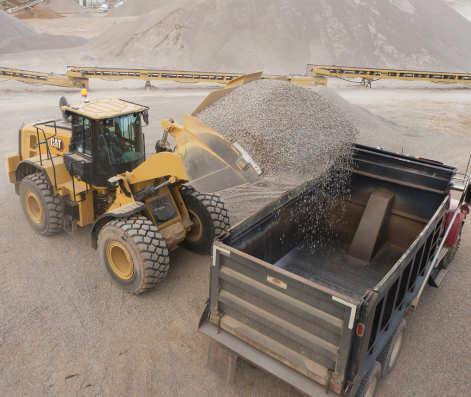
22 minute read
Mining
A mining essential
A consistent flow of new innovations and releases ensures wheel loaders remain an essential piece of machinery on most mining sites.
Afamiliar spectacle found on most mining and construction sites around the continent, most contractors will look no further than wheel loaders to help transport heavy material.
Due to their versatility, mobility, speed and efficiency wheel loaders can function as a primary loading tool or can serve in a support capacity. In addition, their relative ease of maintenance makes these machines formidable pieces of equipment that most sites cannot do without.
Due to their importance, there is a consistent string of innovations and new releases which ensure wheel loaders continue to deliver the most effective performance.
In a bid to boost operator efficiency, Caterpillar has updated the Cat 966 and 972 Wheel Loader series and brought a host of standard technologies to the 7- to 9- tonne line.
Both boast standard Cat Payload with Assist for accurate weighing of bucket payloads and realtime data is fed to the operator display and allows manual tip-off function to improve final bucket adjustments and truck load accuracy. Remote Flash ensures the wheel loaders are operating with the most up-to-date software without impacting production schedules.
Amongst a host of features, the 966 and 972 models deliver consistently high bucket fill factors to increase productivity by up to 10% and their next generation design extends fluid and filter change intervals to lower maintenance costs up to 15% when compared to previous models.
Designed for mastery of even the toughest job site conditions, Hitachi has introduced a larger next-generation model from its Stage V-compliant wheel loader range. The ZW310-7 boasts industryleading safety features and also focuses on operator comfort.
All-round visibility and intelligent systems bring protection for the operator and those on site and high levels of productivity are ensured by fast cycle times, a high breakout force and improved acceleration on inclines thanks to sensors installed on several machine components. Fuel consumption can be monitored via the new ECO gauge and reliability is ensured due to durable components such as axles and frame, intelligent prevention systems and easy maintenance features.
The company noted that owners will feel in total control of their profit thanks to the loader’s powerful performance, low total cost of ownership and exceptional efficiency.
The 966 and 972 models deliver consistently high bucket fill factors.
Sustainable operations
In addition to enhancing performance, there has been a clear intention from equipment manufacturers to deliver sustainable operations –a trend that is being incorporated into wheel loader engineering.
Komatsu, as part of its ongoing process to integrate its legacy brands into ONE Komatsu, has rebranded its hybrid wheel loader products and released the WE1850-3 wheel loader as part of its Generation 3 series.
The WE series of wheel loaders are complete with a fully regenerative SR Hybrid Drive system. During braking or retarding, electrical motors become generators and feed power back into the electrical system, allowing for up to 45% less fuel consumption than comparably sized mechanical drive wheel loaders. Considerable reductions in carbon emissions are also achieved because of this.
In addition, for faster cycle times without a commensurate increase in fuel usage, Generation 3 series wheel loaders include the Kinetic Energy Storage System (KESS), which works in concert with the SR Hybrid Drive to store horsepower captured from braking and direct it to supplement peak power demand.
CASE Construction Equipment has also received a sustainable boost after FPT Industrial approved B20 biodiesel for use in its NEF4, NEF 6 and CURSOS Tier 4 Final diesel engines. All CASE G Series wheel loaders (which feature the engines) have therefore been approved for use with the fuel which can significantly help reduce the carbon footprint of heavy equipment and can help contractors, municipalities, etc, better achieve their renewable goals.
This is the latest example of CASE Construction Equipment’s commitment to the environmental cause as, just last year, it designed and commercially developed the industry’s first electric backhoe loaders for utilities in New York. ■
Rock engineering bar raised
According to SRK Consulting experts, with the world’s most accessible mineral deposits already discovered and developed, extraction conditions are becoming progressively more difficult – making rock engineering more demanding.

As underground mines deepen, there is growing risk of mining-induced stresses and rock bursts.
Image Credit: William Joughin
In open pits, slopes are often required to be steeper, with increased production pressures. As underground mines deepen, there is growing risk of mining-induced stresses and rock bursts. Orebodies also tend to be geologically more disturbed, making them harder to mine.
Orebodies are often exploited from surface using low-cost open pit mining, but as the orebody continues deeper, waste stripping becomes excessive and underground mining is considered. The transition from open pit to underground can be challenging. Many factors, such as the shape and size of the orebody, rock mass characteristics, geological structure, economics, underground mining methods, environmental constraints, management of water, surface infrastructure and impact on local communities need to be considered.
The decision to leave a crown pillar to prevent pit slope failure and subsidence or remove the crown and manage the failure impacts needs to be made at the very beginning. This decision also significantly affects the design of the access to the underground operation, which in turn affects the timing and cost of the transition. Rock engineering plays a major role in all decisions.
Among the underground mining methods available, block caving is often favoured wherever it is feasible, as its cost-effectiveness makes it possible to mine even low-grade deposits economically. However, it does require higher capital costs, including intensive upfront investigation and analysis. While some other methods provide opportunities to learn lessons as mining progresses, block caving is less forgiving – the correct strategies must be adopted from the start.
Engineering effort required
All of this points towards the growing importance of rock engineering design and the various technical inputs that contribute to this complex field. This applies not only from an economic perspective, but equally from the point of view of health and safety as well as operational risk. More geologically disturbed environments present a higher safety risk, requiring greater engineering effort to execute the mine plan.
A comprehensive, integrated approach using a multi-disciplinary team is required, taking into account geological, geotechnical, structural and hydrogeological data. The interpretation of structures and rock mass is vital to anticipating hazardous conditions and can be incorporated into the mining strategies we recommend. The significant impact of water on the stability of pit slopes and underground excavations, especially in shallower operations, highlights the role of the hydrogeologist.
Various methods of analysis are available. Complex numerical modelling can assist in quantifying failure mechanisms, for instance, while a quantitative risk evaluation approach can be used to estimate the impact of slope failure on a mine’s net present value.
The quality of the analysis is only as good as the quality of the data. The tools available to gather the necessary data are constantly improving. SRK makes the most of existing data to focus engineering works from an early stage.
Incorporating new technologies improves investigation methods into rock mass conditions and allows data collection to be conducted remotely where access is unsafe or inaccessible. Some remote tools are also proving useful during the Covid-19 pandemic, when it is difficult to travel and to gain access to mine sites. LiDAR drone surveys have been employed to scan narrow-vein stopes before backfilling, for example. Bathymetric and three-dimensional sonar surveys have even been taken in a mine closed over 50 years ago, improving the spatial understanding of the mine workings themselves, as well as the quality of the rock mass and the stability of the excavation.
The data and analysis must lead to a practical solution, and in this regard there is no substitute for experience. At the end of a complex analysis, the experienced engineer must understand the risks that have been quantified and mitigate these in a safe and cost-effective strategy.
SRK can match the most appropriate team from its global network of consulting practices with the project deposit and operating conditions, including structural geologists, hydrogeologists and numerical modellers. ■
William Joughin, chairman and corporate consultant (rock engineering) at SRK; Ed Saunders, principal consultant (mining rock mechanic) at SRK; and Diane Walker, principal (geotechnical engineering) at SRK.
ABB OPTIMISES MINE HOISTS TO MEET DIGITALISATION TARGETS
ABB has released a new version of ABB Ability Performance Optimization for hoists in order to meet the need for increased digitalisation in the mining industry.
The upgraded digital service enables condition-based maintenance and a higher level of performance optimisation through more sophisticated predictive analytics.
ABB Ability Performance Optimization for hoists 3.1 ensures early detection of hoist abnormality in operations and builds on previous versions to improve uptime, availability, performance and productivity of mine hoists by providing actionable information on KPIs. Hosted on the ABB Ability Edgenius dashboard application, ABB Ability Performance Optimization for hoists enables quick analysis and insights into any plant operation.
The new version offers new KPI settings based on customer and ABB experts’ inputs. New KPIs can be set for service hoist availability, hoist cycle statistics, EMS statistics, brake caliper spring operation times, accumulator pre-charge pressure, deceleration variation, guide rope tension, creep distance and clutching time. Cyber security assessments and solutions for protecting customer data are included.
Predictive analysis of a mine hoist’s condition prevents operations from unexpected shutdowns. Data is automatically collected, segregated and managed to be securely monitored and analysed for actionable insights that can help increase production performance, identify safety hazards and provide optimised maintenance scheduling.
Bengt Hedlund, global service manager hoisting at ABB, said, “As the industry looks to make operations more environmentally sustainable, digital services which support remote operation, such ABB Ability Performance Optimization for hoists, can also play a major role in reducing CO2 emissions and removing the need for on-site service maintenance visits.”
The global Rare Earth Industry Association (REIA) has partnered with BEC GmbH, Circularise, Grundfos and Minviro to lead a three-year EIT RawMaterials-funded innovation project to build a blockchain based Circular System for Assessing Rare Earth Sustainability.
Demand for rare earth metals is skyrocketing and by 2030, it is projected to reach 315,000 tonnes. These metals are irreplaceable and are vitally important to wind turbines, electric vehicles, mobile phones, computers, the defence industry and more. At the same time, the transition to a circular economy is considered crucial. As highlighted by the European Raw Material Alliance (ERMA) Action Plan, boosting supply security through better cooperation among stakeholders is a top priority.
The project will improve the transparency and sustainability of supply chains when it comes to rare earth materials. The partnering organisations aim to integrate REIA’s standards on assessing sustainable performance and Minviro’s LCA tool with Circularise’s blockchain software. This is for traceability and transparency, and will allow Grundfos and BEC GmbH to test the system and business model and trace and measure the environmental impact of supply chains.
The project will contribute to the circular economy transformation in all sectors that depend on rare earths. It will create new business opportunities for manufacturers and recyclers and allow downstream players to ensure sustainable practices.
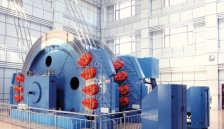
Image Credit: ABB
Predictive analysis of a mine hoist’s condition prevents operations from unexpected shutdowns.
Integrated Pump Rental breaks new ground
Sykes distributor and pump specialist Integrated Pump Rental is offering a readily available pump solution that is built entirely from stainless steel for customers in corrosive environments.
Steve du Toit, rental development manager at Integrated Pump Rental, said that initial interest has come from the mining sector, where mine water being pumped is often acidic. However, he is expecting further interest from the chemical and process industries where corrosive liquids are pumped and stored.
Toit said, “The design is based on our ‘total solution’ approach, where we consider the complete application and its challenges. While the upfront cost of stainless steel is obviously higher, the value gained by the customer in terms of longevity and reliability far outweigh this.”
Among the applications is open pit dewatering where the water pH levels are low, as well as coastal applications where salt water and air cause rapid rusting of mild steel. Integrated Pump Rental has already successfully placed a stainless steel unit in a coastal application, where it is performing well.
“Different grades of stainless steel are used in the design, depending on which components have the most contact with the acidic medium,” Toid added. “A range of materials is therefore employed to suit each application, and to achieve optimal performance at the most competitive cost.”
This custom engineering is made possible by the company’s range of technical skills and specialist experience that resides in its people. This in-house expertise includes draughting, fabrication and pump assembly, making use of coded welders and qualified boilermakers. Depending on the application, the stainless steel build can be supplied on a road trailer or with a site trolley.
Image Credit: Integrated Pump Rental
Integrated Pump Rental is offering a pump solution that is built entirely from stainless steel.
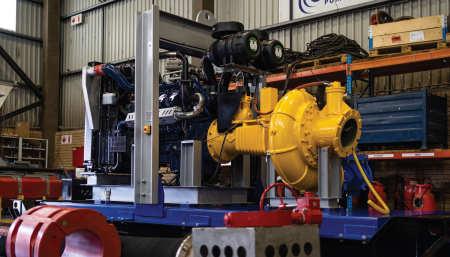
ASSESSING RARE EARTH SUSTAINABILITY
VULCO R67 DELIVERS SUPERIOR WELL LIFE
Vulco Rubber’s abrasion- and impact-resistant rubber compounds are being continually refined by Weir Minerals’ team of expert engineers and material scientists to keep them at the forefront of mill lining systems technology.
Having identified a need for higher-wearing rubbers for mill lining systems, the experts have developed a premium-grade rubber compound with superior wear life and performance in mill lining applications. The result was the Vulco R67 rubber – a material which is manufactured with proprietary new compounds and innovative methods of processing to deliver extended wear life and longer uptime.
Many mining operators from around the globe have implemented the R67 compound into their mill lining systems and have reported as much as 20-40% improvement in wear life, which is resulting in fewer mill lining replacements and longer mill campaigns. This reduction in shutdowns can increase cost savings and improve plant availability.
The R67 elastomer compound is changing the way mills operate. Global trials and commercial installations in the market have resulted in a number of successful outcomes across a variety of different grinding applications.
As an example, a high-grade nickel and copper mining project had a problem where the liners in one ball mill were wearing out too quickly, leading to continued downtime and reduced processing. Initially there was reluctance from the mine, as they had loyalty to their original mill supplier, however after Weir Minerals conducted a series of trajectory simulations and discreet modelling, they agreed to trial the R67 liners. At the end of the trial, the R67 showed 30-40% better performance than the incumbent liners and the customer installed a full set of R67 liners in their mill.
Vulco R67 mill liners are made exclusively at Weir Minerals facilities in South Africa, North and South America, and Australia.
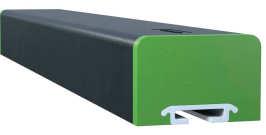
Image Credit: Weir Minerals Africa The Vulco R67 rubber compound combines state-of-the-art technology with advanced raw materials.
UNLOCKING THE POTENTIAL OF IRON ORE TAILINGS
In 2021, benchmark iron price surged by 62% to hit a high of US$220 per metric ton in early 2021 before dropping to just over US$80 in November.
“With the decline in price, one must ask how this will impact iron ore producers?” questioned Gravitas Minerals director Tebogo Kale.
A lower selling price equates to lower revenues for iron ore producers putting a strain on the economic viability of these operations and emphasising the importance of maximising recovery from orebodies.
This can be achieved by exploiting the tolerances of fine material in the export product by recovering the –1 mm fine iron ore fraction from the run-of-mine feed.
Gravitas Minerals has developed the Optima Concentrator gravity separator to recover iron ore from a –3 mm feed. It utilises hindered settling, fluidised bed and autogenous dense medium technology to separate iron ore from gangue based on density.
With high throughput capacities of up to 40 t/h.m2, this is a low-footprint, water-only solution for fine iron ore recovery.
The company has used the Optima Concentrator to develop its Kalahari Process, which produces an iron ore product with a minimum grade of 63% Fe from various iron ore feed sources and has yielded recoveries of up to 80%.
“By utilising the Kalahari Process, iron ore producers can unlock the full potential of their mineral resource. In so doing, they can prolong the lifespan of their tailings’ facilities by up to 50%, reduce the disposal of iron ore tailings and the associated environmental impact, increase their revenues and boost profits,” said Kale.
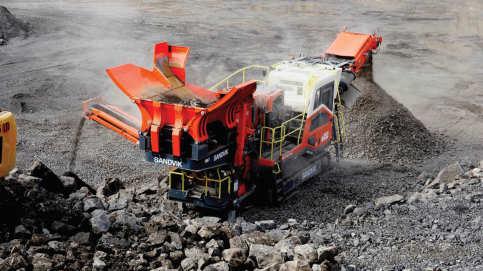
Sandvik’s QI353 maximises performance
Sandvik is revolutionising rock processing with the first of its 3-Series, third generation offering QI353 mobile impact crusher.
Designed to provide more uptime, the QI353 is one of the most versatile, mid-sized mobile impactors available and is built utilising Sandvik’s Prisec technology for primary or secondary applications. It can process up to 400 TPH, whilst reducing fuel and energy consumption.
At the core of the QI353 is a new mid-size Prisec impact crusher, which boasts the largest feed opening 1170 mm x 730 mm and the largest rotor diameter of 1150 mm in its class, for higher capacity and greater energy efficiency. Initial test results have shown up to 16% energy reduction in comparison with previous models.
Fitted with a host of safety features, the QI353 offers 3-sided 270° service access with ground level maintenance points including a new rear access platform. The optional HS323 hanging screen module has been enhanced to accept belt scales for TPH monitoring on fines and stockpile belts.
The QI353 is fitted with the brand new Optik intuitive user experience. This offers simplified operation controls and total integration with My Fleet telematics solution. With a host of easy-tonavigate features, this system allows operators to maximise uptime and optimise decision making with real time information, boost output with diagnostic assistance and enhance troubleshooting with pre-installed guides and accurate data collection.
Sandvik QI353 is fitted with the latest generation fuel-efficient powerpack which provides maximum performance and cost efficiency. The double-deck pre-screen maximises crusher throughput and reduces wear costs and energy consumption.
Image Credit: Sandvik
The QI353 is built utilising Sandvik’s Prisec technology.
Case IH has added the 2150S Early Riser Model to its planter portfolio.
Image Credit: Case IH

Boosting farming productivity
New innovations continue to spur Africa’s growing agricultural sector.
The most recent Africa Agriculture Status Report launched at the 2021 AGFR Summit indicated that Covid-19 demonstrated the fragility of the continent’s food systems despite the progress made over the last decade.
There are, however, immensely positive signs emerging with subSaharan Africa registering the most rapid rate of agricultural production growth since 2000 of any region of the world (even if the growth was driven by the expansion of crop land over yield increases). This is a welcome but very necessary positive trend as the regional population is expanding at a rapid rate (expected to hit 2.5 billion people by 2050), which will require a substantial and robust agricultural foundation to support it.
Andrew Cox, AGRA’s chief of staff and strategy, commented, “Raising yields and productivity on existing farmland is among the most important ways to make African food systems more resilient and sustainable. Raising productivity on existing farmland will reduce pressures for continued expansion of cropland, and preserve valued forest and grassland ecosystems. ”
Within this context, the continued introduction of farming innovations and new machinery is essential and it is with great relief that Grain SA’s NAMPO Harvest Day agricultural Trade Show will be returning live and in-person from 17-20 May 2022.
All sectors of the agricultural input suppliers are represented, ranging from tractor manufacturers to fertiliser companies. Exhibitors from across the world have participated in the show and attendees are looking forward to showcasing their solutions to benefit the African farming industry. On display
One such company which has showcased at the NAMPO conference in previous years is Case IH, which offers a wide variety of agricultural and farming equipment.
The company has released the 2150S Early Riser front-fold trailing planter, which brings productivityboosting split-row configuration to its lineup of 2000 series Early Riser planters. A 525 gallon fertiliser tank capacity – along with more seed capacity – enables operators to cover more acres between fills and make the most of their time in the field. The planters have been boosted with the agronomic benefits of the 2150S.
The company has also unveiled the Precision Disk 550 air drill which is designed to boost yield potential in a variety of crops and tillage practices. This series row unit maintains an industry-leading parallel-link design with new features and enhancements.
A new closing system with indexable angle adjustments delivers effective seed trench closing and adjustments are simple with indexed settings to match field requirements. Additionally, a range of gauge wheel widths and styles accommodate different field and crop conditions and a tank capacity of up to 140 bushels helps operators maximise tendering and seeding productivity.
Trent Nowosad, Case IH marketing manager for seeding equipment, commented, “With this new row unit, every single detail is designed to optimise seed placement and deliver unmatched stand establishment. Even when Mother Nature isn’t on your side, Precision Disk 550 air drills provide peace of mind that plants will get their best start possible.” ■
Advertiser’s Index
Bell Equipment Group Services (PTY) Ltd......................35 Cantoni Motor S.A...................................................................31
Eko Hotel and Suites..................................................................5 Liebherr Export AG....................................................................2 Mantrac Egypt............................................................................33 Teksan Jenerator Elektrik Sanayi ve Ticaret AS..............27 United Kingdom Parts Ltd....................................................41 Volvo Construction Equipment Germany GmbH........52
Tackling urban planning challenges
According to Mammoet, achieving efficient construction in urban environments can be challenging due to changing usage patterns and cities growing dense.
As time passes, infrastructure shows signs of age and is scheduled for replacement; a situation that has been worsened in many countries by burgeoning urban populations creating higher than expected levels of use. These higher populations demand more power, higher travel capacity and larger sewerage systems, meaning more infrastructure is laid on top of the old, making each repair or replacement work more challenging than the last. Declining public budgets only makes this process even more tough.
This all means that in busy, builtup areas with many projects in different phases of development, work on infrastructure can be an extremely complicated and technical challenge. One that must take place with strict guarantees limiting interference to city life, and therefore the wider economic prosperity of the region. But this work is critically important. If transport networks do not perform effectively then the flow of urban life breaks down. Businesses do not have the surety of being able to send or receive goods in a predictable or affordable timeframe, people struggle to commute to work or travel into the city for recreation, and, as a result, the wider economy will start to suffer.

Ageing asset
A driving force in the pressing demand for renewal is the ticking clock of ageing infrastructure, particularly in older cities where transport networks, water supply systems and the like can date back decades or even centuries. The lifespan for which assets such as bridges were built can vary widely –whilst more recently this is typically intended to be around 125 years, in prior decades this has not been the case.
Rafael Martinez, sales manager at Mammoet explained, "In the 1950s, 1960s and 1970s, the lifespan of a bridge was usually only established to be around 50 years. Bridges built in fairly recent memory may be less durable than expected. In addition, the method of construction can vary markedly between bridges of different ages and localities, which means there is no one-size-fits-all solution to removing them when the time comes.”
If not managed properly during its design, environmental conditions can prematurely age an asset.
Unpredictable usage patterns
Assets are only as good as the purpose they were designed for – so if usage patterns change suddenly this can create large challenges.
Nick Jones, commercial manager for Mammoet UK, said, “There are a number of reasons why the usage patterns of infrastructure can change. In some cases, this can be down to changes in government policy influencing how the likes of roads are used.
“But clearly, wider socioeconomic factors are often a key cause – there is still a general trend away from rural living towards cities, which means many urban centers are still experiencing significant growth in population, in parallel with shifting economic development that can also influence the demand placed on water supply and telecommunications, or level of traffic using a bridge on an average day,” Jones added.
Rising populations
Rising populations lead to larger, more complex infrastructure being put in place to support them which presents a number of issues for project planners, as Richard van Looij, Mammoet segment lead for Civil, explained, “As developments expand to accommodate more people, there is not only a reduction in space available to manoeuvre equipment, but also a significant increase in underground services.
“This means that projects have limited room in which to operate equipment such as mobile cranes but will also have restrictions on where heavy equipment can be used as more of these services limit the maximum pressure that the ground can withstand.”
“Smart engineering is needed to work around these challenges, getting the best results within the physical restrictions present. We find that early dialogue with stakeholders is key in achieving this – while we can respond to requirements, the changing nature of the city requires fresh thinking, new methods and equipment that can make a real difference in restricted spaces.”
The situation can be complicated further by non-physical restrictions; limitations on noise and emissions levels are understandably also a major consideration.
Mammoet has dedicated considerable resources to developing new equipment that can meet the changing demands of crowded, complex urban projects. It has pioneered the use of cleaner fuels such as hydrogen and electric power and has developed a new crane called the FOCUS30, which has been designed specifically for projects where greater lifting capability is needed within confined spaces. The relentless nature of our growing cities means regular demand for refurbishment and replacement work to keep transport networks running smoothly. As more cities than ever before come to undertake this type of work, smarter thinking is needed to deliver projects in ways that minimise disruption and can accommodate complex surroundings.
Modern engineered heavy lifting techniques and technologies can offer a range of flexible solutions to meet these challenges; but suppliers must be large enough to offer the right depth of equipment and expertise to meet the unique challenges presented by infrastructure projects. If this can be combined with early involvement to ensure the most effective and bespoke solutions, then cities can be kept moving as freely as possible. ■
Working around existing infrastructure can add several layers of complexity to a project.






